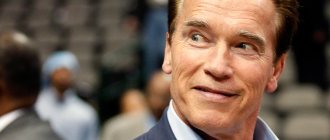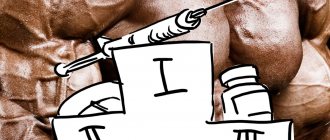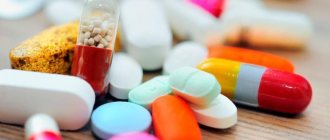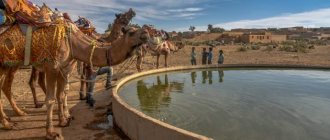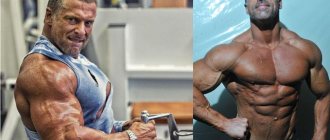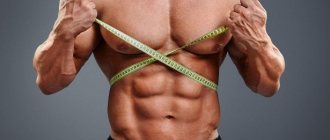Excursion into childhood
Andreas (Andreas Munzer) was born in the fall of 1964 in an Austrian village into a farmer's family. Keeping cows brought good income, but taking care of the farm took up all the time. In his spare time, the teenager visited a local club, where he played the trumpet. In addition to music, there was another hobby - seasonal sports. In winter the boy skied from a springboard, in summer he kicked a ball. After school I went to study to become a mechanic. After classes, he had to wait 2 hours for the bus to get home. The guy didn’t want to wander the streets, so he signed up for a fitness club.
Good start
Soon his fellow gym members noticed that Munzer’s muscle mass was growing faster than anyone else. They suggested that he intensify his training and compete in a junior competition. Second place came as a surprise to the young man. Since then, the athlete has become “sick” of bodybuilding. Ambition forced him to leave his father’s house and go to conquer the Olympic heights. Oddly enough, he succeeded in everything. In 1986, he became a co-owner of the club , which allowed him to reach a different level of life and practice as much as he wanted, which is what he did.
performances in competitive bodybuilding were not inspiring, but he understood that the path to glory lay through the podium. In 1987, the athlete rose to the 3rd place in the World Championships , and repeated the success the following year. At the last event, Albert Busek noticed him and offered to appear for the cover of the most popular magazine FLEX . Andreas was in seventh heaven. For him, this meant more than 1st place in a prestigious competition. Friendly relations developed with Busek, and he offered the guy a vacancy as the manager of a sports center in Munich. The bodybuilder understood that this position would be a springboard for a stellar career and agreed without hesitation. He moved and began to combine work with training.
Subtle and “ringing” Andreas Münzer
In 1989, after winning the World Games, the athlete received the coveted IFBB professional card . With even greater persistence, he began to prepare for the upcoming competitions. The guy pursued the goal of getting closer to his idol in terms of parameters and fame. For the sake of his dream, he combined long work with a strict diet, and 10 days before the tournament he limited the amount of water and took diuretics. As a result, the fat percentage after drying was 4%.
No athlete in the entire history of bodybuilding had such indicators. Detailedly drawn muscles were covered with parchment-thin skin without the slightest hint of fat. Andreas’s figure was compared to an exhibit from an anatomical museum and was nicknamed “the man without skin.”
Despite the ideal terrain, the judges reduced points due to the lack of plasticity and artistry.
At the limit of possibilities
To achieve champion results, he doped , absorbing huge doses of anabolic steroids (50 pieces each) and packs of urinary tablets. The list of drugs includes: thyroid hormone, parabolan, growth hormone, Valius, Stromba and a number of others, except synthol. To restore the mineral balance, I dissolved magnesium and zinc in water and took vitamin tablets.
To train for 6 hours every day, you need strength, but where can you get it from, if not from jars and pharmaceutical packages? But large doses required material costs, and the athlete had to perform 40 times a year. He worked hard, adhered to a diet and did not give his body the slightest break.
The tragedy would not have happened if the bodybuilder took last place - over time, the hope of entering the top three disappeared. But he always made it to the top of the strongest and was two steps away from victory.
“Some people call me crazy and say that I torture myself with harsh discipline. They may be right, but I voluntarily chose this path of self-improvement.”
- In 1990, he took bronze at the Grand Prix in Europe and the Arnold Classic, and showed the 9th result at Olympia.
- In 1993 - silver at the “Night of Champions” and 9th at Olympia.
- In ’94 – 5th position at the Arnold Classic and the same result at the Night of Champions.
- In 95 - 96 - 4 and 5 indicators, getting into the top 10 at San Jose, San Francisco.
| Year | Competitions | Place |
| 1987 | World Amateur Championship | 3 in Light Heavyweight category |
| 1988 | World Amateur Championship | 3 in Light Heavyweight category |
| 1989 | Mr. Olympia | 13 |
| 1990 | Grand Prix Germany | 3 |
| 1990 | Arnold Classic | 3 |
| 1990 | Mr. Olympia | 9 |
| 1991 | Ironman Pro | 3 |
| 1991 | Arnold Classic | 9 |
| 1991 | Pittsburgh Pro | 4 |
| 1991 | Mr. Olympia | — |
| 1993 | Grand Prix Germany | 2 |
| 1993 | Arnold Classic | 7 |
| 1993 | Night of Champions | 2 |
| 1993 | Grand Prix Germany | 4 |
| 1993 | Mr. Olympia | 9 |
| 1994 | Grand Prix Germany | 5 |
| 1994 | Arnold Classic | 5 |
| 1994 | Mr. Olympia | 9 |
| 1994 | Grand Prix France | 8 |
| 1995 | Arnold Classic | 4 |
| 1996 | San Jose Pro | 7 |
| 1996 | Arnold Classic | 6 |
| 1996 | San Francisco Pro | 7 |
Zhukov, Turchinsky, Schwarzenegger - celebrities whose lives and health were ruined by steroids
The fact that the 42-year-old lead singer of the group “Hands Up!” serious health problems, it became clear after Sergei Zhukov interrupted his August tour and recorded a video message to fans while in the hospital. As Zhukov said, he will have another operation in August, but he did not go into details.
It is known that in his youth the artist spent a lot of time in the “rocking chair”. According to the former producer of the group “Hands Up!” Andrei Malikov, Sergei used anabolics - anabolic steroid hormones, drugs for quickly building muscle mass.
They could easily have become one of the reasons that caused Zhukov’s current health problems. Their dangers have been talked about more and more often lately; there are quite a lot of famous people among those affected by such drugs. Sometimes everything ended tragically. We decided to recall the most revealing stories and famous people whose names were associated with the use of steroids.
Nikolay Shilo
A Minsk bodybuilder who trained in an ordinary basement became the first Soviet bodybuilding champion, winning first place at the European Championships in 1988. Nikolai Shilo did not live to see the World Championships, at which he was also predicted to win a prize and for which he was intensively preparing.
Two months later, the 27-year-old bodybuilder died. A common cold was complicated by sepsis, and a few days later the athlete died in intensive care. They said that steroids could have killed Shiloh, although friends and coaches assured that there was no talk of any excessive use of drugs.
But then almost no one talked about another “side” of steroids: they greatly weaken immunity. And the simplest disease can have dire consequences, even fatal.
Vladimir Turchinsky
“If I tell you that I never used it, I would be lying,” Dynamite fans quote him as saying in an interview in response to a direct question about whether he took steroids. In his book “Explosive Philosophy,” published in 2006, Vladimir Turchinsky explained in detail why such drugs are dangerous.
The multiple record holder in strength sports, actor and TV presenter died in December 2009 in the prime of his life, at 46 years old. After the death of Turchinsky, whom many considered a big man, many versions appeared. According to one of them, the cause of Vladimir’s death could have been the use of hormones.
According to one of the doctors, he said that he was taking steroids, and shortly before his death he said that he changed the drug and complained of feeling unwell. Turchinsky's widow Irina categorically denied this version. The medical report listed the cause of his death as acute coronary insufficiency, simply put, a heart attack.
What “planted” the man’s heart - the intense pace of life and work, heavy physical activity, or indeed, the use of steroids (even in the past, as they said, not a single bodybuilder could do without them in the 90s), of course, no one can answer.
Sylvester Stallone
The star of “Rambo” and “Rocky” used hormones for many years. “He used steroids with all his might,” said one of Sylvester’s mistresses. Stallone himself avoided direct answers to the question about steroids, but admitted that he acquired the muscles that made him famous throughout the world thanks to the fact that he regularly took growth hormone.
And now he is forced to take it to stay in shape and maintain his health. Today “Sly” is 72 years old, he looks great for his age, but many do not know that the actor has long had problems with the heart and blood vessels, sick tendons and “weak” bones.
Arnold Schwarzenegger
Schwarzenegger was on steroids in the 60s. As “Iron Arnie” explained, at that time bodybuilders simply did not know any better, and no one had yet thought about the dangerous consequences. And very little was known about the side effects of steroids back then.
“If you want to become a champion, you push everything into yourself,” Arnold Schwarzenegger once admitted. According to him, as soon as he learned about the dangers of steroids, he immediately stopped taking them.
But Arnie's health had suffered. Schwarzenegger has liver problems, and his heart began to go crazy when the actor was not even 50 years old. Schwarzenegger had his first heart surgery in the late 90s.
Andreas Münzer
The famous Austrian bodybuilder, world champion in bodybuilding, who went down in history as a man without skin (outwardly he looked like an anatomical model - only muscles) died at the age of 31 in 1996. His idol was Schwarzenegger.
Münzer took a variety of drugs to increase his endurance, from steroids to diuretics. By the age of thirty, his body was seriously worn out.
During an emergency operation due to bleeding in the intestines, it turned out that the athlete’s blood had become abnormally viscous, his liver was almost destroyed, and his heart could not cope with the load. An autopsy showed that Andreas Münzer used dozens of anabolic drugs.
Rich Piana
The American bodybuilder and "Mr. California" died in 2017 at the age of 46. Rich Piana openly admitted that he was on steroids. According to one version, it was their overdose that killed him.
Before his death, the bodybuilder spent three weeks in a coma. After an autopsy, it turned out that the cause of death could not be determined. Rich was diagnosed with numerous heart, liver, and lung diseases, an enlarged spleen and thyroid gland, and brain damage, including necrosis of brain cells.
Nicole Bass
Nicole Bass-Fuchs, the famous American bodybuilder, the “Iron Lady”, who held the title of the most powerful female bodybuilder in the world, died in the winter of 2020 after a massive stroke. At that time she was 52 years old.
Bass has never hidden the fact that she uses steroids. Nicole began having serious heart problems 10 years before her death, and in 2006, her life was almost taken by inflammation of the pancreas, caused, again, by excessive use of steroids.
Previously, Sensum wrote how a female bodybuilder turned into a man - the terrible power of steroids.
Workout
According to the athlete, only concentration on one group ensures results. The six-day classes were structured according to the following scheme:
- Monday: in 3 approaches in the morning, afternoon and evening I pumped up the chest, back, and abs.
- On Tuesday, according to the plan - cardio, biceps, deltoids, calves.
- Wednesday – legs and triceps.
- From Thursday to Saturday I repeated everything in a circle.
Basic postulates:
- Münzer trained with moderate weights .
- The main thing is to use your last strength to perform a couple of extra repetitions until muscle failure . Worked with small groups of up to 16 accounts.
- The number of repetitions for large muscles reached 24-28.
Diet and training from Münzer[edit | edit code]
Andreas Münzer: “Since 1987, even in the off-season, I train twice a day, 6 times a week. Here is my double split diagram:
| DAY | TIME | PART OF THE BODY |
| 1 | morning evening | chest, cardio training back, abs |
| 2 | morning evening | biceps, deltoids, cardio training |
| 3 | morning evening | triceps legs |
| 4-6 | morning evening | repetition of training days 1-3 |
| 7 | Rest |
An example of a set diagram (approaches per muscle group)[edit | edit code]
Large muscle groups
- chest, back, legs:
- Off-season - 20 sets.
- Pre-competition period - 24-28 sets.
Small muscle groups
- biceps, triceps, deltoids, calves:
- Off-season -16 sets.
- The pre-competition period is 20-24 sets.
I prefer to work on one muscle group during training - this allows me to concentrate on it 100 percent. This is impossible if attention has to be divided into several muscle groups. It’s better for me to work on one group in the morning, and in the evening I’ll come back to the gym and work on another with the same concentration.
Becoming a serious bodybuilder is difficult. Not everyone has time for two workouts a day, six times a week. But don’t be upset: experience shows that you can achieve good results with one workout a day, 4-5 times a week.
The most important thing in bodybuilding is consistency in training. Nothing can replace regular exercise, since only regular exercise transfers the entire physiology of the body to maximum anabolism. At the same time, it doesn’t matter at all whether you can bench press 150-180 kg. The whole point is to pump up the muscle efficiently, without giving any concessions. The training weight may be relatively small, but to the last repetition you must add 2-3 repetitions through force, stepping behind the so-called. "refusal". If you are capable of this, you are simply doomed to progress.
But you need to eat at least 5 times a day - this is fundamentally important. The body must replenish nutrients, especially proteins. For me, the ideal ratio is 7 g of protein per day per 1 kg of body weight. Protein sources include egg whites, chicken and turkey breasts, low-fat cheese and protein powders. Carbohydrates include potatoes, rice, oatmeal and some types of vegetables. I eat little fruit and no sugar at all. I drink 8-10 liters of water a day. I add magnesium to the water to ensure a balance of minerals. As supplements, I prefer multiminerals and multivitamins with amino acids. In addition, I additionally take vitamin A and zinc.”
Deep muscle division from Münzer[edit | edit code]
Andreas Münzer: “It is very important to work with a weight that allows you to do only 8 full repetitions. Then, with the help of a partner, do another 2-3 repetitions and bring their total number to 10-11. The main thing is for the muscles to work with maximum tension.”
Relief quality from Münzer[edit | edit code]
Andreas Münzer: “My relief is not a natural gift, as many people think. This is the result of strict diets and hard training. At first, just like others, I made “quality,” as they say, for show. I started to “dry” a couple of months before the next tournament. But then I tried to stay in shape, first for a month, then for two, then I learned to be at the peak of my relief all year round. By the way, many of my friends tried my system and got the same result.
Many people believe that squats, bench presses and leg presses are exercises only for mass, and, say, bench presses are only for detail. I disagree. Each exercise in itself does not mean anything. It all depends on HOW you do it.”
Bodybuilding philosophy from Munzer[edit | edit code]
Andreas Münzer: “I just can’t agree with what’s happening in professional bodybuilding today. For some reason, the judges took maximum muscle mass as the starting point. In my opinion, this is pushing our entire sport down the wrong path. Harmony, symmetry, muscle quality and artistry are all forgotten. Quantity has prevailed over quality. But is overall muscle mass really that important? Doesn't it make a bodybuilder an anti-athlete - heavy and clumsy? Personally, I have never prioritized my body weight. The main thing for me has always been perfection of proportions. In this sense, I was my own judge. I consciously refused to blindly follow newfangled market trends. I had my own ideal, which I sought to embody in my muscles.”
Tragedy
The athlete did not attach any importance to poor health. In March 1996, acute pain began in the stomach and bleeding began . At the age of 31, he died from hemorrhoidal pathology in the abdominal cavity. The surgeon diagnosed drug-induced cirrhosis , the pathologist found almost 200 different hormones in the blood.
The idol sent a wreath to the funeral. But Andreas made plans - he wanted to get the championship title and marry a bodybuilder named Elizabeth.
Steroids and Diuretics
Steroids by themselves will not drag you into the grave, unlike Diuretics, which are used to achieve “peak relief”. . The fact is that diuretics lead to blood thickening . In this state, it is very difficult for it to move through the vessels and your pump (heart) has to work harder to push it through (heart rhythm disturbance, acute heart failure).
Both Benaziza and Münzer died because their hearts could not cope with such a load . Both had complications even before the diuretics. Benaziza suffered from a hereditary kidney disease, which hastened his death. And Müntzer was an experienced ulcer. Remember his abdominal bleeding that started it all. By the way, I personally believe that it was not diuretics that killed Münzer, but Cytadren, with which he blocked all the cortisol that was not needed for large muscles, but very necessary in emergency situations, such as internal bleeding.
Conclusion: Diuretics are deadly and can cause death very easily when used. But there are two problems here:
- Diuretics are used only by competitive bodybuilders. This would never occur to ordinary gym athletes.
- 2. Diuretics ARE NOT STEROIDS! These are completely different teachers who use only a few.
